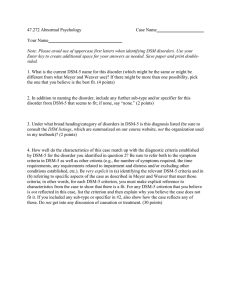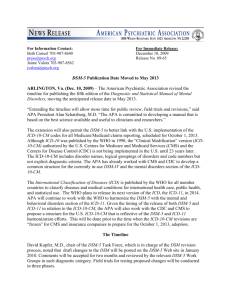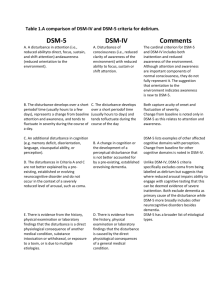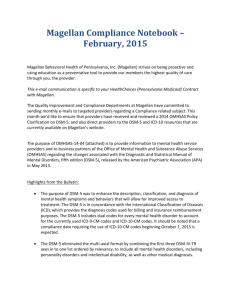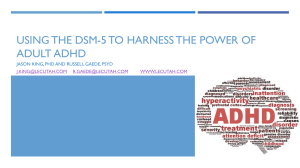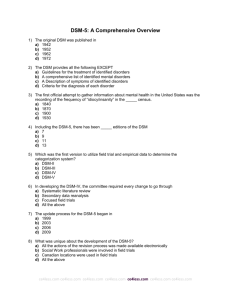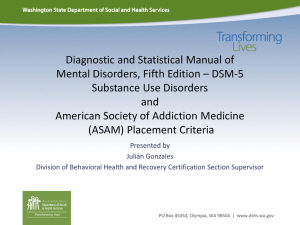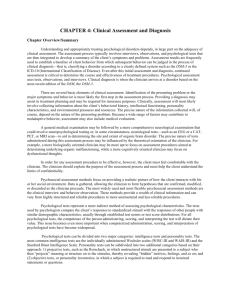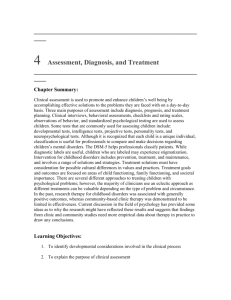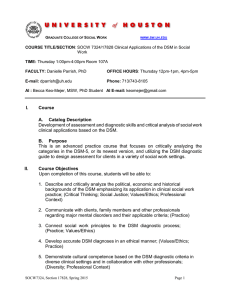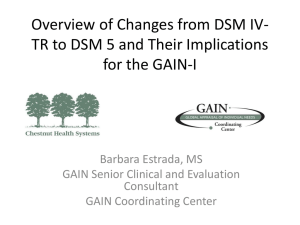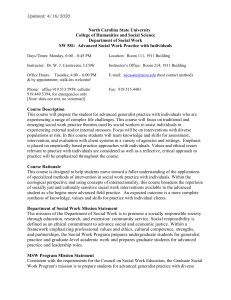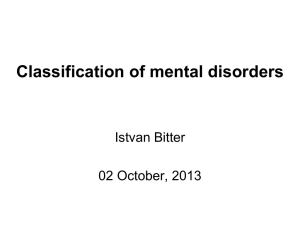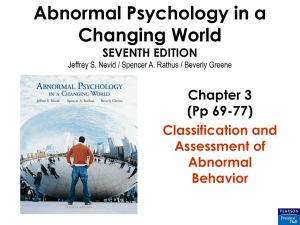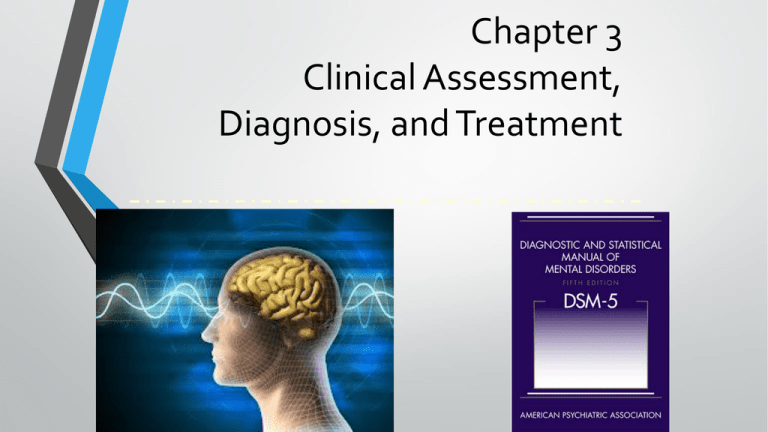
Chapter 3
Clinical Assessment,
Diagnosis, and Treatment
The **** Personality Inventory
1 = strong agreement
2 = some agreement
3 = little agreement
4 = no agreement at all
The **** Personality Inventory
________ a.
I like spending time with other people.
________ b.
I have realistic dreams and goals.
________ c.
People are only looking out for their own interests.
________ d.
I have frequent nightmares.
________ e.
I prefer to use humor to cope with stress.
________ f.
When I get nervous, I have problems thinking clearly.
________ g.
I worry about how I spend my time.
________ h.
My feet and hands are usually cold.
________ i.
I’d like to travel around the world.
•
Clinical Assessment: How and Why Does the Client
Behave Abnormally?
• Assessment: collecting relevant information to reach conclusion
• Used to determine how and why person is behaving
abnormally/how person may be helped
Used for several purposes
Making predictions, planning treatments, and evaluating
treatments
4
Clinical Assessment: How and Why Does the Client
Behave Abnormally?
• Hundreds of clinical assessment tools have been developed
and fall into three categories:
•
•
•
Clinical interviews
Tests
Observations
5
Characteristics of
Assessment Tools
• To be useful, assessment tools must be standardized and have clear
reliability and validity
•
To standardize a technique is to set up common steps to be followed
whenever it is administered
6
Characteristics of Assessment Tools
• Reliability refers to the consistency of an assessment
measure
• A good tool will always yield the same results in
the same situation
7
Characteristics of Assessment Tools
• Validity refers to the accuracy of a tool’s results
• A good assessment tool must accurately measure
what it is supposed to measure
8
Clinical Interviews
• Face-to-face encounters; often the first contact between
client and clinician/assessor
• Used to collect detailed information, especially
personal history
• Allow interviewer to focus on whatever topics
considered most important
• Focus depends on theoretical orientation
9
Clinical Interviews
• Conducting the interview
• Can be either unstructured or structured
• In an unstructured interview, clinicians ask open-ended
questions
• In a structured interview, clinicians ask prepared questions,
often from a published interview schedule
• e.g., SCID (Structured Clinical Interview for DSM)
10
Clinical Tests
• Devices for gathering information about aspects of a
person’s psychological functioning.
11
Clinical Tests
Projective tests
•
•
•
Require that clients interpret vague or ambiguous stimuli or
follow open-ended instruction
Psychodynamic
Most popular:
•
•
Rorschach Test
Thematic Apperception Test (TAT)
12
Clinical Test:
Rorschach Inkblot
13
Thematic Apperception Test (TAT)
Clinical Tests
Personality inventories
•
•
•
•
Designed to measure broad personality
characteristics
Focus on behaviors, beliefs, and feelings
Usually based on self-reported responses
Minnesota Multiphasic Personality Inventory
(MMPI)
15
MMPI
• Consists of 567 self-statements that can be answered “true,”
“false,” or “cannot say”
•
Statements describe physical concerns, mood, sexual behaviors, and
social activities
• Comprised of ten clinical scales:
•
•
•
•
•
Hypochondriasis
Paranoia
Depression
Psychasthenia
Hysteria
Schizophrenia
Psychopathic deviate
Hypomania
Masculinity-femininity
Social introversion
16
Clinical Test: MMPI
Minnesota Multiphasic Personality Inventory
•
Graphed to create a “profile”
17
Clinical Tests
Response inventories
•
•
Usually based on self-reported responses
Focus on one specific area of functioning:
•
•
•
Affective inventories (Beck Depression Inventory)
Social skills inventories
Cognitive inventories
18
PSYCHOLOGICAL ASSESSMENT PROCEDURES
Beck Depression Inventory (BDI-II)
0) I do not feel sad.
(1) I feel sad.
(2) I am sad all the time and I can't snap out of it.
(3) I am so sad or unhappy that I can't stand it.
Measures: changes in sleep patterns, appetite, feelings of being punished,
thoughts about suicide, interest in sex
21 questions
0–13: minimal to no depression
14–19: mild depression
20–28: moderate depression
29–63: severe depression.
Higher total scores indicate more severe depressive symptoms.
Clinical Tests
Psychophysiological tests
•
Measure physiological response as an indication of
psychological problems
•
•
Includes heart rate, blood pressure, body
temperature, galvanic skin response, and muscle
contraction
Polygraph (lie detector)
20
Clinical Tests
Neurological and neuropsychological tests
Neurological tests directly assess brain function by assessing
brain structure and activity
Neuropsychological tests indirectly assess brain function by
assessing cognitive abilities (inhibition, memory, spatial
perception).
21
Clinical Tests
Intelligence tests
•
Typically comprised of a series of tests assessing
both verbal and nonverbal skills
22
Clinical Observations
Self-monitoring
• People observe themselves and carefully record
frequency of certain behaviors, feelings, or
cognitions as they occur over time
23
Diagnosis: Does the Client’s Syndrome Match a Known
Disorder?
• Using all available information, clinicians attempt to
determine if a person’s psychological problems
comprise a particular disorder
24
Classification Systems
• Lists of categories, disorders, and symptom descriptions, with
guidelines for assignment
• Focus on clusters of symptoms (syndromes)
• In current use in the U.S.: DSM-5
• Diagnostic and Statistical Manual of Mental Disorders (5th
edition)
25
DSM-5
• Lists approximately 400 disorders
• Describes criteria for diagnoses, key clinical features, and
related features that are often, but not always, present
26
Lifetime Prevalence of
DSM Diagnoses
27
DSM-5
• Requires clinicians to provide two types of
information:
• Categorical
• Dimensional
28
DSM-5
• Categorical Information
• Clinician must decide whether person is displaying one of
hundreds of disorders listed in the manual
• Some of most frequently diagnosed are anxiety disorders and
depressive disorders
29
DSM-5
• Dimensional Information
• Diagnosticians also are required to assess current
severity of client’s disorder
• For each disorder, various rating scales are
suggested
30
Is DSM-5 an Effective Classification System?
• Judged by its reliability and validity
• DSM-5 followed certain procedures to help ensure
greater reliability and validity (conducting extensive
literature reviews and running field studies)
• Despite such efforts, critics still have concerns
31
DSM 5
• Key changes to DSM 5 include
• additions to and removals of diagnostic
categories
• reorganizing of categories
• changes in terminology
32
Can Diagnosis and Labeling
Cause Harm?
• Misdiagnosis always a concern
• Major issue: reliance on clinical judgment
• Issue of labeling and stigma
• Diagnosis may be self-fulfilling prophecy
• Because of these problems, some clinicians would like to
do away with the practice of diagnosis
33

